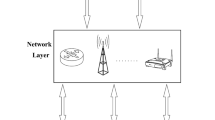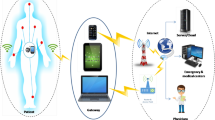Abstract
As wireless sensor networks (WSNs) are widely used in unattended environments, various physical attacks are occurred easily. In this paper, location and trust based replica detection (LTBRD) method is introduced to identify the replication attack in the wireless sensor network. As sensor nodes are not tamper proof, all the credentials can be copied into any number of nodes. In order to solve this issue, behavior based and certificate based trust along with location information is followed in our proposed LTBRD approach. Depending upon the location mismatch and the trust value the malicious node will be identified and it will be revoked from the network. In this approach, the efficiency of the algorithm is been achieved by aggregation as well as without aggregation. The performance of LTBRD is evaluated with the help of detection probability, energy consumption, network delay, memory requirement. The performance of LTBRD is proven theoretically and the result shows that the proposed algorithm outperforms well when compared with the existing algorithms such as RED and LSM.
















Similar content being viewed by others
References
Pratihari, H. N. (2013). A survey on security issues in wireless sensor network. International Journal of Computer Science and Mobile Computing A Monthly Journal of Computer Science and Information Technology, 2(7), 55–58.
Akyildiz, I. F., Su, W., Sankarasubramaniam, Y., & Cayirci, E. (2002). Wireless sensor networks: A survey. Computer Networks, 38(4), 393–422.
Liu, D., & Ning, P. (2004). Multilevel μTESLA: Broadcast authentication for distributed sensor networks. ACM Transactions on Embedded Computing Systems (TECS), 3(4), 800–836.
Ho, Y., Ma, R., Sung, C., Tsai, I., Kang, L., & Yu, C., (2015). Deterministic detection of node replication attacks in sensor networks. In International conference on consumer electronics (pp. 468–469).
Parno, B., Perrig, A., & Gligor, V. (2005). Distributed detection of node replication attacks in sensor networks. In 2005 IEEE symposium on security and privacy (pp. 49–63). IEEE.
Karl, H., & Willig, A. (2007). Protocols and architectures for wireless sensor networks (pp. 7–8). Hoboken: Wiley.
Yves, A. J., & Hao, P. (2015). RSSI-based indoor localization using RSSI-with-angle-based localization estimation algorithm. Sensor Networks and Data Communications, 4(122), 2.
Conti, M., Di Pietro, R., Mancini, L., & Mei, A. (2011). Distributed detection of clone attacks in wireless sensor networks. IEEE Transactions on Dependable and Secure Computing, 8(5), 685–698.
Braginsky, D., & Estrin, D. (2002). Rumor routing algorithm for sensor networks. In Proceedings of the 1st ACM international workshop on wireless sensor networks and applications (pp. 22–31). ACM.
Fu, F., Liu, J., & Yin, X. (2007). Space-time related pairwise key predistribution scheme for wireless sensor networks. In International conference on wireless communications, networking and mobile computing, 2007. WiCom 2007 (pp. 2692–2696). IEEE.
Newsome, J., Shi, E., Song, D., &Perrig, A. (2004). The sybil attack in sensor networks: Analysis and defenses. In Proceedings of the 3rd international symposium on Information processing in sensor networks (pp. 259–268). ACM.
Sugano, M., Kawazoe, T., Ohta, Y., & Murata, M. (2006). Indoor localization system using RSSI measurement of WSN based on ZigBee standard. Target, 538, 050.
Choi, H., Zhu, S., & La Porta, T. F. (2007). SET: Detecting node clones in sensor networks. In Third international conference on security and privacy in communications networks and the workshops, 2007. SecureComm 2007 (pp. 341–350). IEEE.
Stallings, W. (2006). Cryptography and network security: Principles and practices (pp. 290–300). Delhi: Pearson Education India.
Wander, A. S., Gura, N., Eberle, H., Gupta, V., & Shantz, S. C. (2005). Energy analysis of public-key cryptography for wireless sensor networks. In Third IEEE international conference on pervasive computing and communications, 2005. PerCom 2005 (pp. 324–328). IEEE.
Goualard, F. (2014). How do you compute the midpoint of an interval? ACM Transactions on Mathematical Software (TOMS), 40(2), 11.
Baker, D. J., & Ephremides, A. (1981). A Distributed algorithm for organizing mobile radio telecommunication networks. In International conference on distributed computing systems ICDCS (pp. 476–483).
Zhu, B., Addada, V. G. K., Setia, S., Jajodia, S., & Roy, S. (2007). Efficient distributed detection of node replication attacks in sensor networks. In Twenty-third annual computer security applications conference, 2007. ACSAC 2007 (pp. 257–267). IEEE.
Sohraby, K., Minoli, D., & Znati, T. (2007). Wireless sensor networks: Technology, protocols, and applications (pp. 202–220). Hoboken: Wiley.
Qi, Z., & Ping, H. (2013). The topology construction power control algorithm based on birthday paradox. In 2013 International conference on computer sciences and applications (CSA) (pp. 223–228). IEEE.
Brooks, R., Govindaraju, P. Y., Pirretti, M., Vijaykrishnan, N., & Kandemir, M. T. (2007). On the detection of clones in sensor networks using random key predistribution. IEEE Transactions on Systems, Man, and Cybernetics, Part C (Applications and Reviews), 37(6), 1246–1258.
Zhang, M., Khanapure, V., Chen, S., & Xiao, X. (2009). Memory efficient protocols for detecting nodereplication attacks in wireless sensor networks. In Proceedings of 17th IEEE international conferenceon network protocols, ICNP’09 (pp. 284–293). Princeton, NJ: IEEE.
Sei, Y., & Honiden, S. (2008). Distributed detection of node replication attacks resilient to many compromised nodes in wireless sensor networks. In Proceedings of the 4th annual international conference on wireless internet, WICON’08 (pp. 01–08). Brussels, Belgium: ICST.
Znaidi, W., Minier, M., & Ubeda, S. (2009). Hierarchical node replication attacks detection in wirelesssensors networks. In Proceedings of IEEE 20th international symposium on personal, indoor andmobile radio communications, 09 (pp. 82–86). Tokyo: IEEE.
Conti, M., Pietro, R. D., Mancini, L. V., & Mei, A. (2007). A randomized, efficient, and distributed protocol for the detection of node replication attacks in wireless sensor networks. In Proceedings ofthe 8th ACM international symposium on mobile ad hoc networking and computing, MobiHoc’07 (pp. 80–89). Montreal, Canada: ACM.
Ko, L. C., Chen, H. Y., & Lin, G. R. (2009). A neighbor-based detection scheme for wireless sensor networks against node replication attacks. In Proceedings of international conference on ultra modern telecommunications and workshops, ICUMT’09 (pp. 1–6). St. Petersburg: IEEE.
Krishnamachari, L., Estrin, D., & Wicker, S. (2002). The impact of data aggregation in wireless sensor networks. In Proceedings 22nd international conference on distributed computing systems workshops, 2002 (pp. 575–578). IEEE.
Author information
Authors and Affiliations
Corresponding author
Rights and permissions
About this article
Cite this article
Amudha, G., Narayanasamy, P. Distributed Location and Trust Based Replica Detection in Wireless Sensor Networks. Wireless Pers Commun 102, 3303–3321 (2018). https://doi.org/10.1007/s11277-018-5369-2
Published:
Issue Date:
DOI: https://doi.org/10.1007/s11277-018-5369-2




